
A chase plane is an aircraft that "chases" a "subject" aircraft, spacecraft or rocket, for the purposes of making real-time observations and taking air-to-air photographs and video of the subject vehicle during flight. [1]

A chase plane is an aircraft that "chases" a "subject" aircraft, spacecraft or rocket, for the purposes of making real-time observations and taking air-to-air photographs and video of the subject vehicle during flight. [1]
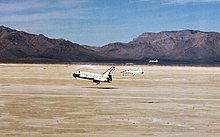
Safety can be one function of a chase plane; others are to photograph or video the target vehicle, or to collect engineering data from it. Chase planes may be used during flight tests, and for many years the best way to ensure the safety of an experimental aircraft was to fly alongside it and observe the flight.[ citation needed ]
This "chase" airplane's crew would keep a constant lookout for problems with the "subject" or test aircraft, and if problems did arise, they would provide warnings and critical information to the test aircraft's crew, and to the mission controllers on the ground. They would also monitor the surrounding airspace for other aircraft that could pose a hazard to the flight, either by straying into their flightpath or threatening any kind of secrecy associated with that particular project. [ citation needed ]
Since the early days of United States Air Force testing, the chase aircraft have been crewed by test pilots just like the experimental planes they accompany, providing a common language and bond between test pilot and observer. The experienced pilots in the chase aircraft could guide distressed test aircraft down to safe landings should experiments go wrong.[ citation needed ]
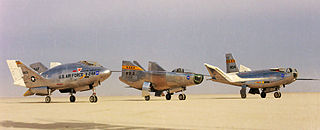
A lifting body is a fixed-wing aircraft or spacecraft configuration in which the body itself produces lift. In contrast to a flying wing, which is a wing with minimal or no conventional fuselage, a lifting body can be thought of as a fuselage with little or no conventional wing. Whereas a flying wing seeks to maximize cruise efficiency at subsonic speeds by eliminating non-lifting surfaces, lifting bodies generally minimize the drag and structure of a wing for subsonic, supersonic and hypersonic flight, or spacecraft re-entry. All of these flight regimes pose challenges for proper flight safety.

The Kegworth air disaster occurred when British Midland Airways Flight 092, a Boeing 737-400, crashed onto the motorway embankment between the M1 motorway and A453 road near Kegworth, Leicestershire, England, while attempting to make an emergency landing at East Midlands Airport on 8 January 1989.

The Bell X-2 was an X-plane research aircraft built to investigate flight characteristics in the Mach 2–3 range. The X-2 was a rocket-powered, swept-wing research aircraft developed jointly in 1945 by Bell Aircraft Corporation, the United States Army Air Forces and the National Advisory Committee for Aeronautics (NACA) to explore aerodynamic problems of supersonic flight and to expand the speed and altitude regimes obtained with the earlier X-1 series of research aircraft.

The Bell X-5 was the first aircraft capable of changing the sweep of its wings in flight. It was inspired by the untested wartime P.1101 design of the German Messerschmitt company. In a further development of the German design, which could only have its wing sweepback angle adjusted on the ground, the Bell engineers devised a system of electric motors to adjust the sweep in flight.

The Rockwell-Messerschmitt-Bölkow-Blohm X-31 is an experimental jet aircraft designed to test fighter thrust vectoring technology. It was designed and built by Rockwell and Messerschmitt-Bölkow-Blohm (MBB), as part of a joint United States and German Enhanced Fighter Maneuverability program to provide additional control authority in pitch and yaw, for significantly more maneuverability than most conventional fighters. An advanced flight control system provided controlled flight at high angles of attack where conventional aircraft would stall or lose control. Two aircraft were built, of which one has survived.

A test pilot is an aircraft pilot with additional training to fly and evaluate experimental, newly produced and modified aircraft with specific maneuvers, known as flight test techniques.

Aviation safety is the study and practice of managing risks in aviation. This includes preventing aviation accidents and incidents through research, educating air travel personnel, passengers and the general public, as well as the design of aircraft and aviation infrastructure. The aviation industry is subject to significant regulation and oversight.
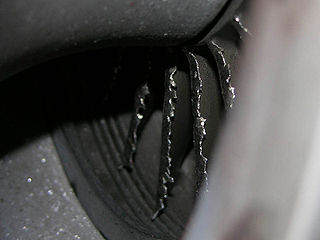
In aviation and aerospace, the term foreign object damage (FOD) refers to any damage to an aircraft attributed to foreign object debris (also referred to as "FOD"), which is any particle or substance, alien to an aircraft or system which could potentially cause damage to it.

The Convair XFY-1 Pogo is an experimental V/STOL aircraft developed during the early years of the Cold War. It was intended to be a high-performance fighter aircraft capable of operating from small warships. Lockheed and Convair were awarded contracts to build experimental VTOL fighters, with Convair producing the XFY-1, also known as the "Pogo." It was developed as an attempt to create a practical V/STOL aircraft.

On April 7, 1994, Federal Express Flight 705, a McDonnell Douglas DC-10-30 cargo jet carrying electronics equipment across the United States from Memphis, Tennessee, to San Jose, California, was the subject of a hijack attempt by Auburn R. Calloway, a Federal Express employee facing possible dismissal for having lied about his flight hours.
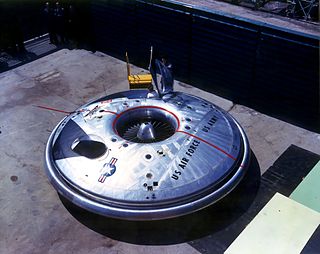
The Avro Canada VZ-9 Avrocar is a VTOL aircraft developed by Avro Canada as part of a secret U.S. military project carried out in the early years of the Cold War. The Avrocar intended to exploit the Coandă effect to provide lift and thrust from a single "turborotor" blowing exhaust out of the rim of the disk-shaped aircraft. In the air, it would have resembled a flying saucer.
Flight testing is a branch of aeronautical engineering that develops technologies and equipment required for in-flight evaluation of behaviour of an aircraft or launch vehicles and reusable spacecraft at the atmospheric phase of flight. Instrumentation systems for flight testing are developed using specialized transducers and data acquisition systems. Data is sampled during the flight of an aircraft, or atmospheric testing of spacecraft. This data is validated for accuracy and analyzed to further modify the vehicle design during development, or to validate the design of the vehicle.

The Rockwell RPRV-870 HiMAT is an experimental remotely piloted aircraft that was produced for a NASA program to develop technologies for future fighter aircraft. Among the technologies explored were close-coupled canards, fully digital flight control, composite materials, remote piloting, synthetic vision systems, winglets, and others.

On October 25, 1999, a chartered Learjet 35 business jet was scheduled to fly from Orlando, Florida, United States to Dallas, Texas, United States. Early in the flight, the aircraft, which was climbing to its assigned altitude on autopilot, lost cabin pressure, and all six on board were incapacitated by hypoxia, a lack of oxygen in the brain and body. The aircraft continued climbing past its assigned altitude, then failed to make the westward turn toward Dallas over North Florida and continued on its northwestern course, flying over the southern and midwestern United States for almost four hours and 1,500 miles (2,400 km). The plane ran out of fuel over South Dakota and crashed into a field near Aberdeen after an uncontrolled descent, killing all six on board.

Airbus Industrie Flight 129 was an Airbus Industrie A330-321 test flight that ended in a crash on 30 June 1994 at Toulouse–Blagnac Airport, killing all seven people aboard. The last test flown was to certify the plane's takeoff capability with a single engine failure. It was the first fatal accident involving an Airbus A330 as well as the first hull loss of the type.
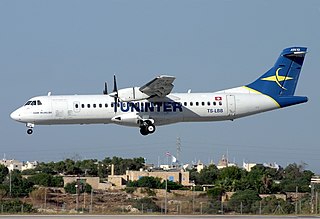
Tuninter Flight 1153 was a Tuninter Airlines international flight from Bari International Airport in Bari, Italy, to Djerba-Zarzis Airport in Djerba, Tunisia. On 6 August 2005, the Tuninter ATR 72 ditched into the Mediterranean Sea about 18 miles (29 km) from the city of Palermo. Sixteen of the 39 people on board died. The accident resulted from fuel exhaustion due to the installation of fuel quantity indicators designed for the ATR 42 in the larger ATR 72. It was also Tuninter's first fatal accident in the 14-year history of the company.

Aviation communication refers to the conversing of two or more aircraft. Aircraft are constructed in such a way that make it very difficult to see beyond what is directly in front of them. As safety is a primary focus in aviation, communication methods such as wireless radio are an effective way for aircraft to communicate with the necessary personnel. Aviation is an international industry and as a result involves multiple languages. The International Civil Aviation Organization (ICAO) deemed English the official language of aviation. The industry considers that some pilots may not be fluent English speakers and as a result pilots are obligated to participate in an English proficiency test.

TAME Flight 173, a Boeing 737-2V2 Advanced operated by Ecuador's national airline TAME, flying on a domestic route from the now-closed Mariscal Sucre International Airport in Quito to Mariscal Lamar International Airport in Cuenca, crashed on 11 July 1983 into a hill during final approach just 1 mile from its final destination, killing all 119 people on board.

On 27 April 2012, a multinational team of television studios staged an airplane crash near Mexicali, Mexico. An unmanned Boeing 727-200, fitted with numerous cameras, crash test dummies and other scientific instruments, was flown into the ground. The exercise was filmed for television.

The VSS Enterprise crash occurred on October 31, 2014, when the VSS Enterprise, a SpaceShipTwo experimental spaceflight test vehicle operated by Virgin Galactic, suffered a catastrophic in-flight breakup during a test flight and crashed in the Mojave Desert near Cantil, California. Co-pilot Michael Alsbury was killed and pilot Peter Siebold was seriously injured.